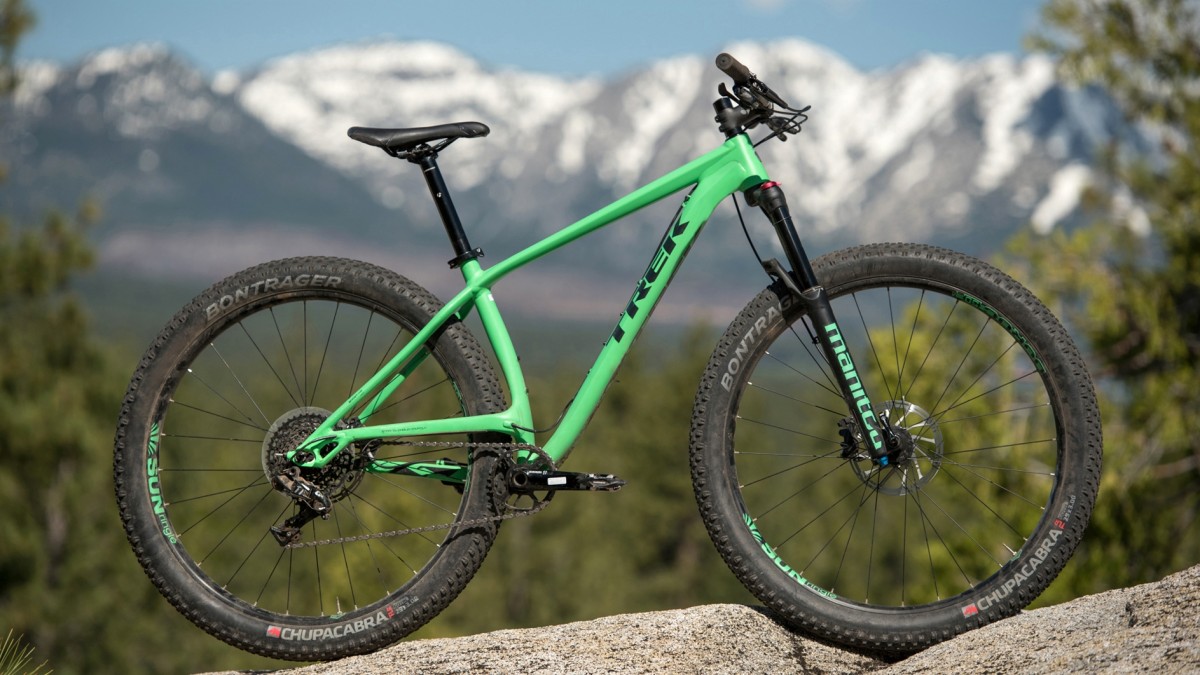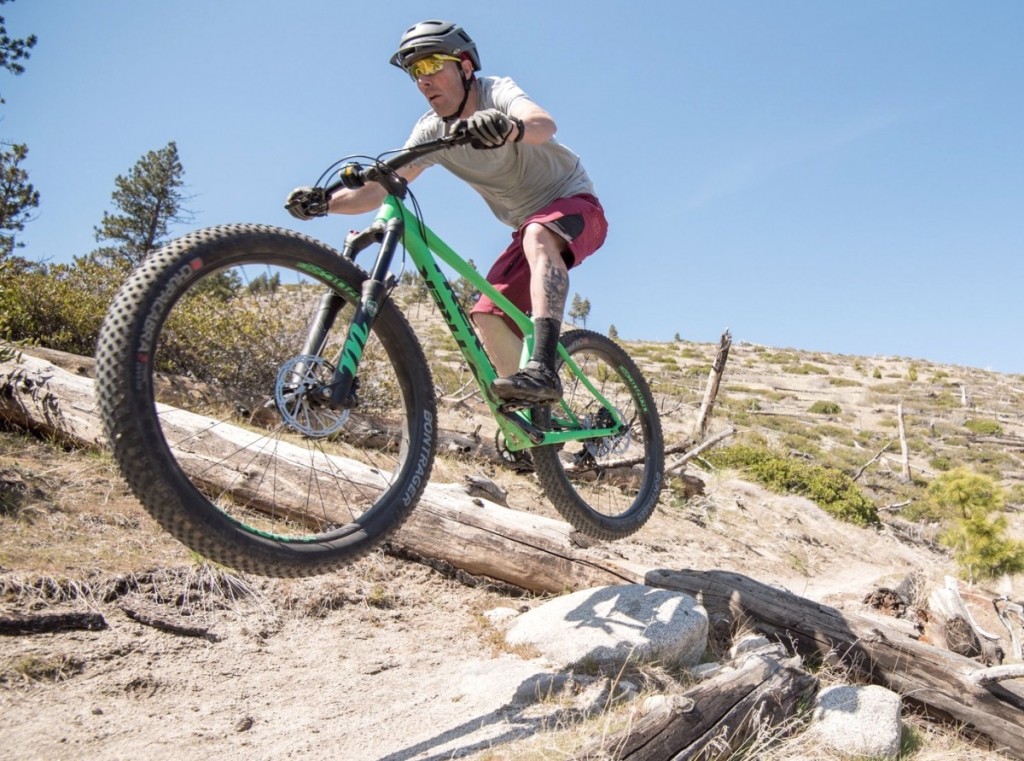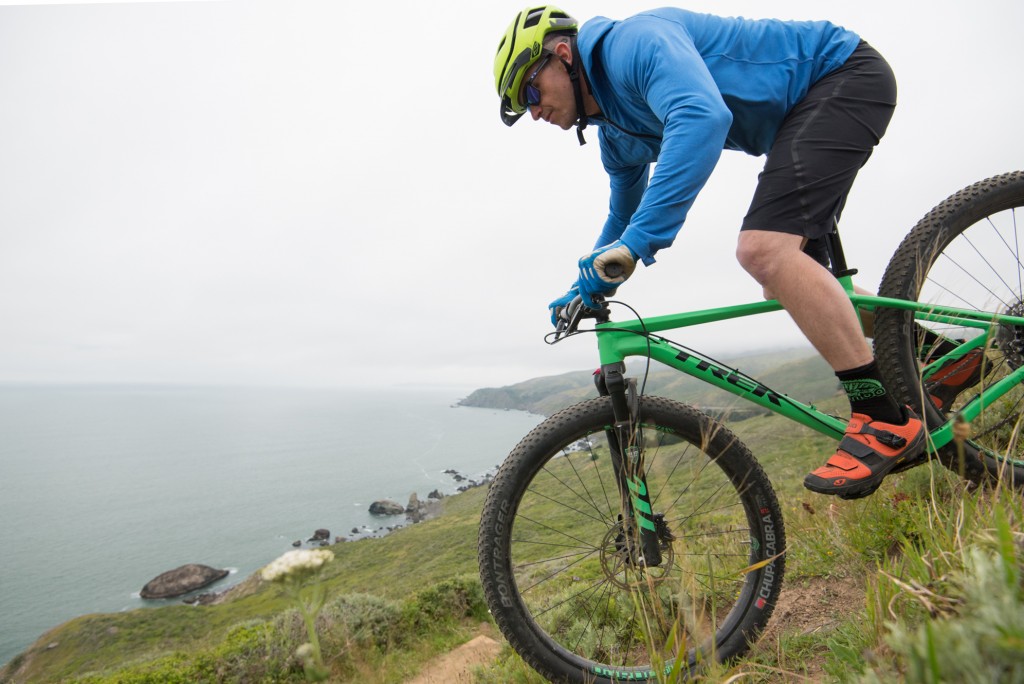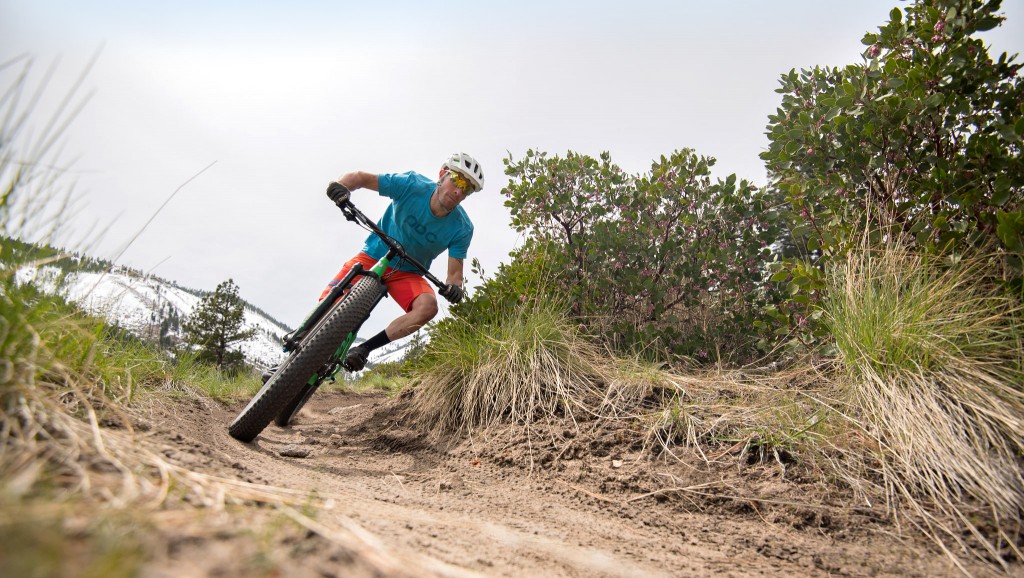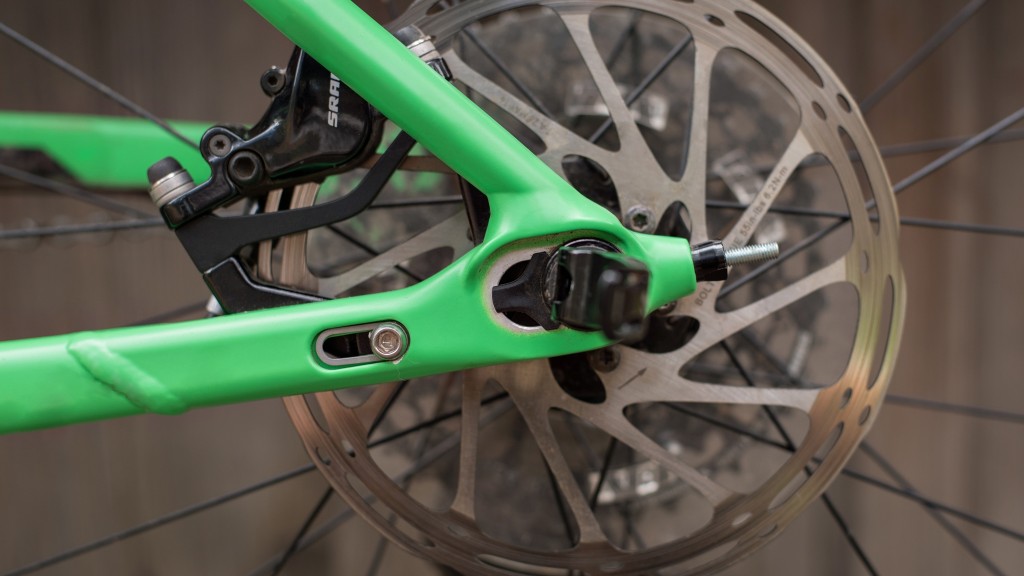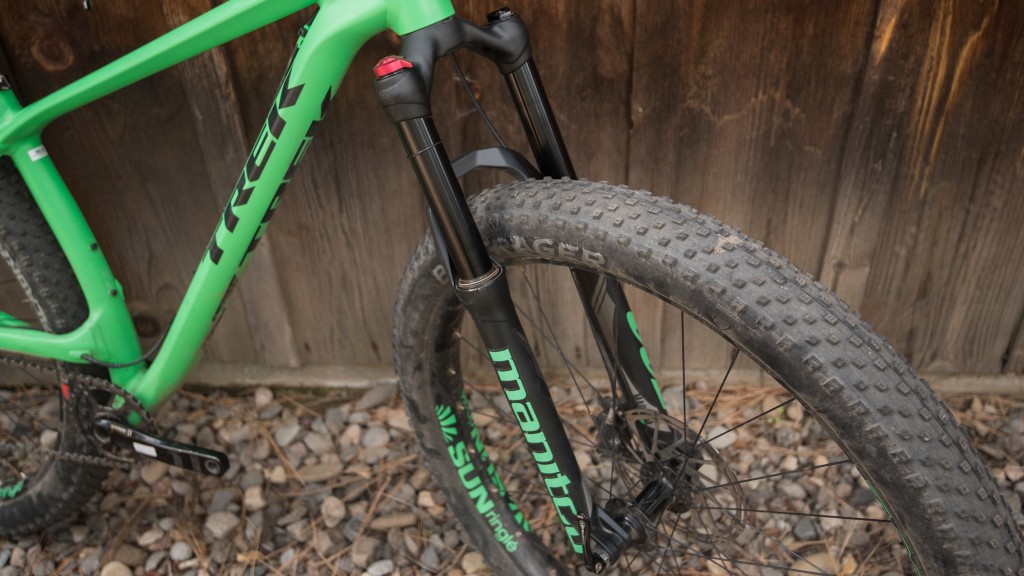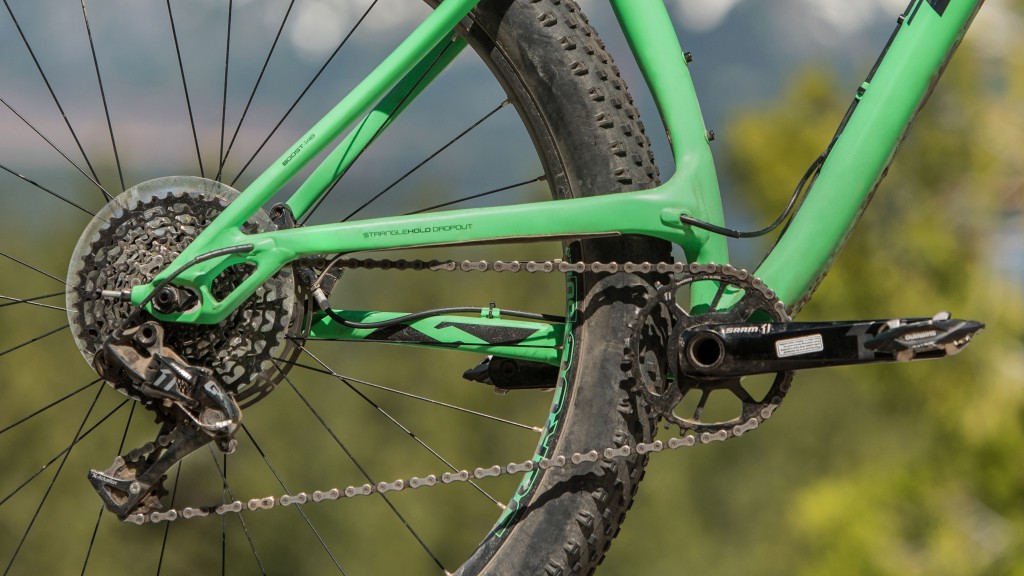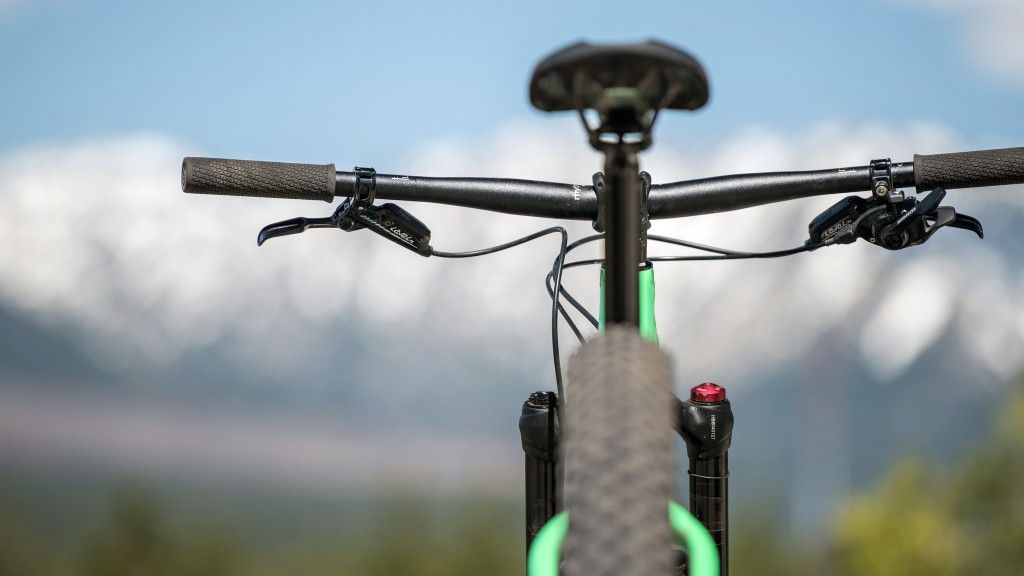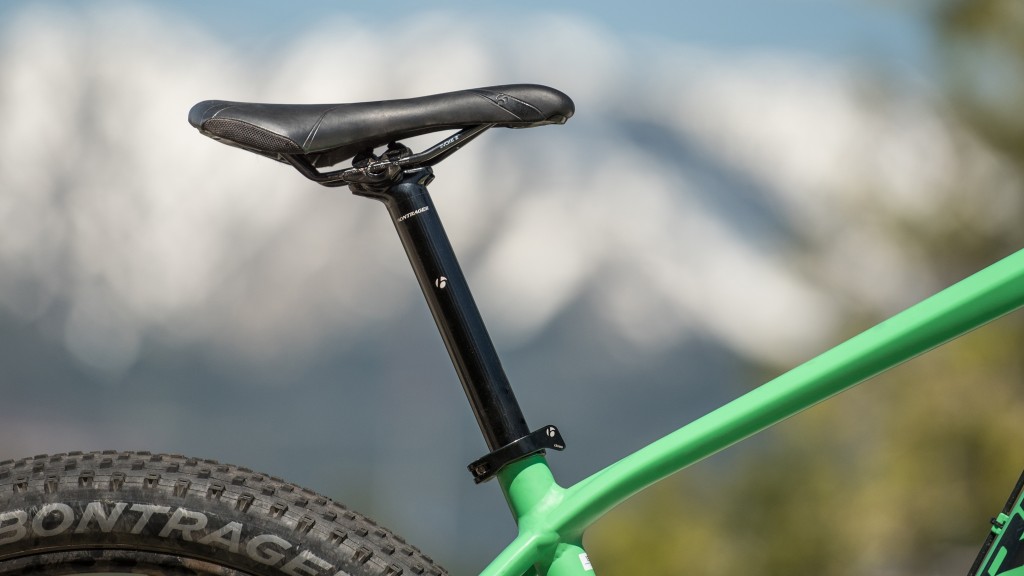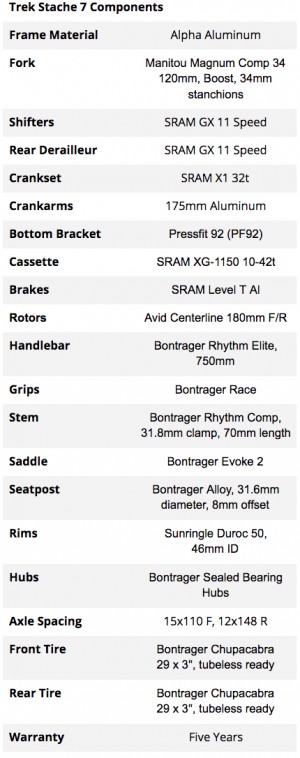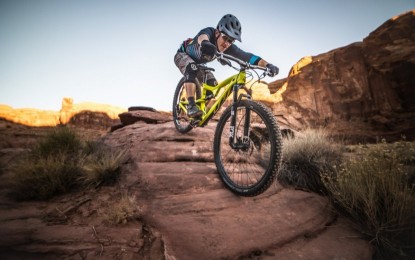Trek Stache 7 2017 Review
Our Verdict
Our Analysis and Test Results
2018 Analysis and Test Results
Four testers rode hundreds of miles and 128 timed laps on the Trek Stache 7, 2017 Specialized Fuse Expert 6Fattie, 2017 Santa Cruz Chameleon R1+, 2017 Salsa Woodsmoke 29 NX1, and 2017 Kona Honzo AL/DL. We rated them on their fun factor (worth 25%), build quality (15%) and downhill, climbing and cornering skills (20% each). You can find all about this comparison in our Hardtail Trail Bike Review. We also compared these hardtails to the full suspension bikes we've tested in our best trail mountain bike review.
Fun Factor
One tester says this bike belongs in the amusement park. He was throwing shade, but amusement parks are fun. Smashing through technical sections at high speeds and taking sweeping corners with so much traction you might as well be on roller coaster rails — the Stache is not a bad time. The grip of the 29 x 3" tires just doesn't let up, and the wheels monster-truck over anything in your way. If you're open to a different type of riding, you're gonna have fun. You just have to figure out if it's the type of riding you want to do all the time.
While the Stache's steering is precise, it takes a while to adjust your line choices to a wide turning bike with such burly tires. The Stache is just too big and heavy to throw around. You've got to be aggressive to work it through tight turns on descents, more so than the Specialized Fuse or Santa Cruz Chameleon. The bars are stubborn, and the front wheel kicks back harder than we're used to if you hit a rock at an awkward angle. On the other hand, if you keep the front wheel aligned with obstacles, you can just sit and spin through pretty much anything with stability and confidence.
Once you've got all that down, the Stache's tall feel and lack of a dropper post still stifle light-hearted fun. The upright cockpit is comfortable for climbing but can be disconcertingly high on aggressive descents. Dropping your body low enough to rip down rock gardens and around downhill turns is a struggle. Also, while the tire squish can make the Stache feel a tad more like a full suspension trail bike, there's no compression or rebound dampening the tires. So you get a running downhill in moon boots sensation at times. It's a weird feeling, but those tires keep showing up for you, making short work of anything in the way.
That same bounding sensation can also be frustrating on the climbs, especially when combined with sluggish acceleration. But the bike's inertia ensures that once you get the Stache going, it holds and builds speed nicely.
The Stache's fun factor is at the bottom of the stack. It's not that it's bad. It's just so very specific in its applications. The Specialized Fuse is fun in a much broader array of circumstances and rates higher. In general, full suspension bikes are more fun.
Downhill Performance
The Stache's big bike feel gives you a solid base to confidently attack descents. It's tractor tires cushion chatter and the large contact patch provides never-ending traction. The resulting stability comes at the expense of maneuverability, making the Stache stubborn about switching lines or working around turns.
The Stache is never described as nimble. It's a hefty green machine to swing around, feeling much heavier than its 30 pounds, 2 ounces. As a result, it requires more planning than a tossable bike like the Specialized Fuse or Santa Cruz Chameleon. The bike's inertia wants to hold you to your first line choice. Your best bet is to stick with it, as the larger-than-life tires will probably roll through anyway.
The other chink in the Stache's downhill domination is the upright riding position it enforces. Again, the lack of a dropper and the shallow seat tube, which restricts how far into the frame you can drop the rigid post, make it very hard to crouch low or move back into an aggressive descending position. On steep hills, this high positioning combines with a steeper head tube angle, 68.4-degrees, to make us feel destined for an OTB situation.
On rapid-fire hits, the rebounding bounce of the 29+ tires can shake your composure. Once you're prepared for it, it's a good reminder that you don't have any real rear suspension. So, you should probably slow your roll. A full suspension bike has more control over all surfaces. The Stache has that undampened bounce while rear shocks can be controlled by compression and rebound adjustments.
The Stache is slow to start but it keeps gathering speed, ramping up through the straightaways until we have to shut it down for a turn. We never topped it out, despite lots and lots of trying. Our downhill time trials were too wind affected to produce any results except for one. The Stache was undoubtedly the fastest climbing bike in the test.
When stacked up against the best trail bikes in the business, the Stache is ranked toward the bottom for its lack of versatility. The Fuse is a more composed and capable descender, though it only rates a bit higher in a field that includes full suspension bikes.
Climbing Performance
The Stache's upright positioning works better for the uphill. The 68.4-degree head tube angle translates to direct steering, and the 29+ tires roll right over rocks. Riders can just sit and spin most of the time, but you need power to do so. If you have it, the Stache climbs moderate hills with ease. Steep, punchy sections expose the inherent gravity of the rig. Two of our testers are comfortable climbing on the Stache. One feels the positioning is too upright and resents the lack of skill it takes to climb the trail.
In a word, the Stache's traction is "amazing." According to one tester, "if you spin out on this thing I don't know what to say." These tires are so big that you can run them at higher and more efficient pressures and while still enjoying the same grip you'd expect with 27.5+ wheels at lower psi.
The Stache is a solid climber but the Specialized Fuse is easier to accelerate. The smaller diameter wheels get rolling more quickly than the 29+ wheels on the Stache. The Santa Cruz Tallboy is a far more comfortable climber for long grids uphill. The lower weight of the normal 29-inch wheels save a lot of energy even if they sacrifice some traction.
Even though the Stache is a quad burner, the pain will be over faster than you think. The bike slogged to second place in our timed climbing trails, switchbacking up hardpack singletrack just behind the Specialized Fuse. It's still too tiring to want to take on an all-day climb, but it's certainly efficient enough to get up the hill for the thrill of coming back down.
The Stache's stiff rear end is enough to earn it a 5 out of 10 for climbing abilities, at the back of the hardtail pack and lagging behind most of the full suspension rigs. Most full suspension bikes are now adept enough at isolating pedal forces from their suspension action that they climb as well as a hardtail. In the case of plus size hardtails, maybe a little better.
Cornering, Handling, and Body Language
Piloting this green beast certainly takes some adjustment. One of our testers took a while to settle into the bike. Its tall rider position had him feeling too high above the trail and disconnected from the tires. After he figured out that the handling is precise if you can find a line that accommodates the bike's heft, he felt right at home. Another tester started out enjoying it, saying it steered as well as the Specialized Fuse, and ended up loathing it's imprecise cornering and heavy feel. The others enjoyed it throughout.
The Stache gets around uphill switchbacks relatively easily, it just takes forethought and a wider line. The traction and rock rollover skills make up for it's longer turning radius. The real challenge is muscling it around the descending turns. You have to plan ahead to find your line and aggressively lean into the turn.
The Bontrager Chupacabra 29 x 3" tires don't have the telltale bite of a cornering knob that so many bikers appreciate. The tread keeps rolling towards the sidewall of the tire, gripping the dirt at almost every angle. This is a great feeling for imprecise beginners and is functional enough for more skilled riders to appreciate.
Ease of Maintenance
It is important to consider maintenance costs and complications when purchasing a bike. Full suspension bikes have more moving parts and require more frequent service compared to the relatively simple hardtail bike. We consider the Trek's fork and brakes in the ease of maintenance scores below. Read more about the rankings in the main trail bike review.
The Trek Stache is a beautifully simple hardtail bike. Manitou recommends servicing their fork less frequently than RockShox options but more frequently than Fox. The bike's SRAM brakes are more difficult to bleed than Shimano.
Frame Design
The Stache 7 is 29+, 29 and 27.5+ capable, due to its stranglehold dropout chainstay adjustment system. This system lets the rear axle dropout slide 15mm fore and aft to accommodate different wheel sizes and a geared or single speed drivetrain. Similar chainstay adjustments are available on the Santa Cruz Chameleon and Salsa Woodsmoke. We tested the Stache in its longest chainstay iteration.
The Stache is a big bike, with its Alpha aluminum frame standing tall on 29 x 3" tires. We measured its bottom bracket height at 331mm and standover height at 850mm, by far the loftiest in the test. It also has the shortest wheelbase in the test, measured at 1118mm. The compact base is thanks to a steeper head tube angle, 68.4-degrees, and relatively short chainstays, 421mm in their longest setting. The shorter wheelbase balances the bulk of the bike's 29+ wheels. While the head tube angle is the steepest in the test, it's still reasonably slack. Pairing the relaxed head angle with a 120mm fork makes the Stache a more versatile trail bike than its traditional, cross-country focused predecessors.
A bend in its steep 77.3-degree seat tube makes the Stache's rigid seat post the tallest in the test. It makes moving back for descents a desperate affair despite the relatively short top tube, measured at 608mm. That's a bummer because the Stache's green-light color definitely stands for "on your mark, get set, go."
Build
The Stache's pretty good performance is matched by a pretty good component spec. There's nothing special here, but it all comes together nicely.
Cockpit and Fit — As we've mentioned, this is a big bike with an upright cockpit that sets you up in the stratosphere. The 18.5" frame size we tested works best for testers on the upper limits of a medium sized bike. You're not likely to lose that tall bike feel in smaller sizes though. The bottom bracket height doesn't drop any lower in the smaller sizes (17.5" and 15.5") and you only lose only about a centimeter in standover height for every size down. That's why a dropper post is such an important upgrade. The length of the bike isn't overly problematic, just don't expect to slap this green monster around on the trails without a fight.
Fork — It's nearly impossible to separate the performance of the 120mm travel Manitou Magnum Comp 34 fork from the squish of those 29 x 3" tires. They work together to provide plenty of squish. It's a passable fork. And, since it is so hard to separate its performance from the tires, it may well be a waste to upgrade to nicer fork on this bike.
Of Note: The reverse brake arch on the Stache's Manitou Magnum Comp 34 exposes more of the stanchions than their 120mm travel would suggest, adding about 30mm. This fork looks like it has 150mm of travel. It doesn't.
Wheels and Tires — The Bontrager Chupacabra 29 x 3" tires are wrapped around massive 46mm inner width rims. They don't lack any traction. The 28 wheel spokes seem light for such massive wheels. The tires might absorb enough impact to shield the wheel from any excessive beatings, and we didn't notice any flex, but we'd like the assurance a few more spokes would provide.
Groupset — The 30-tooth SRAM X1 crankset worked with the SRAM 10 to 42-tooth cassette to provide an adequate gear range for our testing purposes. The SRAM GX shifter and derailleur provided crisp shifts between them.
The SRAM Level brakes with centerline 180mm rotors shut the Stache's endless acceleration down effectively.
Handlebars, Seat, and Seatpost — The Bontrager Rhythm Elite 750mm bar is adequate, though on the narrow side, especially when stretched out over the front wheel on a 70mm stem. The combination worked fine for our testing purposes and gave the cockpit enough room to be comfortable on the climbs. Still, we would prefer a shorter stem and wider bar for better leverage to control that bossy front tire.
Build Options
There are some options when it comes to the Stache's build kit. Here's a rundown.
For $2,999.99 the Stache 9.6 gets you an OCLV Mountain Carbon frame, a RockShox Yari RC fork, SRAM Guide R brakes, and a KS eThirty Integra dropper post. The wheels and drivetrain are the same as the Stache 7. The frame, brakes, and dropper are solid upgrades. We didn't care much for the Yari fork on our test bike the Kona Honzo. If you really want carbon, the jump might be worth it, but you could throw on a dropper on the Stache 7 for much less.
The 9.8 gets Gucci at $4,699.99 with the same carbon frame, a RockShox Pike RC, carbon Bontrager wheels, SRAM Guide RS brakes, and a SRAM X1 drivetrain. If you can afford it, this will certainly showcase the Stache's skills to their utmost.
Value
For middle-of-the-road performance and a middle-of-the-road build, the Stache 7's $2100 price tag offers a middle-of-the-road value. This is a bike you could take on almost any trail (within reason) without as much upkeep as a full suspension.
Suggested Upgrades
We'd slap a dropper post on this bike before taking it out on its first ride. The ability to get low in the turns and back on steep sections of trail would make for a more pleasant ride. A shorter stem and wider bar would help wrangle the green beast. A different seat would make all that time in the saddle much more comfortable.
Conclusion
One of our testers describes the Trek Stache as a cheater bike, with endless traction, and near full-suspension squish. Indeed, its planted feel keeps you confident on the descents. Its rolling speed, traction and solid pedaling also make it a surprisingly speedy and efficient climber. Still, vague cornering and steering demands will frustrate riders who enjoy employing their well-honed handling skills. It's hard to recommend this as your only ride. The Stache can feel overly innovative when compared to more traditionally wheeled bikes. But the benefits of 29+ are worth considering for your quiver.


